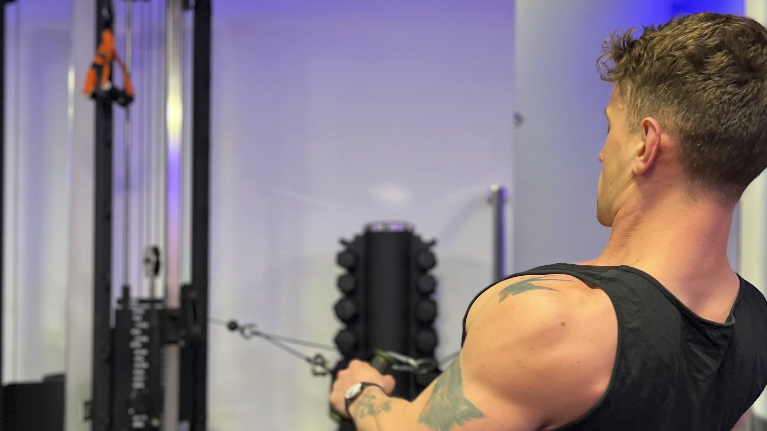Sometimes the lingo around exercise can feel a little bit impenetrable. If you’ve ever sought out a training program you’ve more than likely come across the terms ‘sets’ and ‘reps’.
If you’re not quite sure what that means, never fear. We’re here to demystify it.
‘Sets’ and ‘reps’ meaning
A ‘rep’ is short for repetition and refers to how many times you perform an exercise before taking a break. A ‘set’ refers to the grouping of those repetitions.
For example, if you were to perform 4 sets of 5 reps of bench press, you would perform the movement 5 times, take a break to recover and then repeat a total of 4 times.
How many reps should there be in a set?
The number of reps you perform in a set totally depends on your goals.
In very basic terms, there are 3 rep ranges we tend to work with, depending on the goal.

Generally speaking, for a strength focus the target number of reps will be lower, with a heavier resistance. Anywhere between 1-8 reps for a total of 3-10 sets may be programmed, with the higher number of reps being geared more towards a strength/hypertrophy goal. More on this below.
For hypertrophy (muscle growth) the number of reps will generally be higher. Somewhere between 3-6 sets of 7-12 reps is a good rule of thumb. However, there are a number of different approaches to hypertrophy training that will diverge from this. For example, performing 8 sets of 3 reps rather than 3 sets of 8 reps, with less rest time, has been shown to be an effective technique.
When it comes to hypertrophy, there are 3 mechanisms to address:
Mechanical tension – created by using a heavy load and performing exercises through full ROM. The time the muscle spends under tension is referred to as mechanical tension. You may also see this referred to as ‘time under tension.’
Muscle damage – microtears sustained during resistance training are repaired during the recovery period, allowing for muscle growth to occur. This onset of muscle damage triggers mTor pathways that then activates protein synthesis to occur and the rebuilding of the damaged muscle.
Metabolic stress – Along with lifting heavy weights to create mechanical tension, lifting moderate to light weights for higher repetitions, will also promote muscle growth.

With the muscles continually contracting and relaxing a blood pooling effect is created within the muscle. This results in restricted blood flow to the muscle and with the lack of oxygenated blood being able to fuel the muscle during the contractions. This leads to a large build-up of metabolites like lactate, hydrogen ions etc. The resulting metabolic stress placed on the muscles has an anabolic effect leading to molecular signalling, an increased hormonal response and muscle growth.
With that said, rather than a specific number of sets or reps being the key to hypertrophy, what’s more important is manipulating the reps and sets to tick off the 3 mechanisms of muscle growth.
Finally, if muscular endurance is the goal, reps will be much higher. Generally in the 15-30+ range.
What’s a good combination of reps and sets for strength?
Broadly speaking, beginners will gain significant strength and muscle mass early on at relatively moderate ranges of sets and reps, with progressive overload (continued increase of intensity) built into their training. Anywhere in the range of 3-5 sets for 3-5 reps, with adequate rest time, will be sufficient.
As you become more experienced, more nuanced approaches can be applied. The below is a very broad guideline, there are innumerable approaches to building strength. These are not exact prescriptions, specific goals will need more specific approaches but the below acts as a good rule of thumb.

For the development of maximal strength try 3-5 sets at 1-3 reps with 80% of your rep max.
For explosive strength, 6-10 sets of 1-3 reps with between 60-70% of your rep max may be performed. The key in this instance is to perform the movement as fast as possible, while maintaining good form.
For a combination of strength and hypertrophy (with slightly more emphasis on strength than a high rep, purely hypertrophy focussed approach) 4-8 sets of 4-8 reps at 70-80% of your rep max will yield good results.
Numbers of sets for strength vs cardio
Developing strength is all about overcoming external load and stimulating mechanical tension. This is only possible with heavy resistance training. Developing cardiovascular capacity is all about getting your heart rate up and working your cardiovascular system, which can only be achieved through prolonged bouts of exercise.

That means you will be much less active in a strength focussed workout, as the focus is on performing low reps with a heavy weight, than you will be in a cardio focussed workout where the goal is to get your heart rate up by staying active. It’s unlikely you’ll be particularly out of breath after performing a 1 rep max on the bench press.
Using reps to measure a cardio workout is fairly atypical. It’s much more likely to be measured in time, distance or through heart rate monitoring. There is of course some crossover, you may find yourself out of breath when performing certain strength focussed movements, but the cardiovascular benefits are more likely to be a bonus rather than the main goal.
If you have any questions about the kinds of sets and reps needed for strength training, you’re welcome to contact us!

